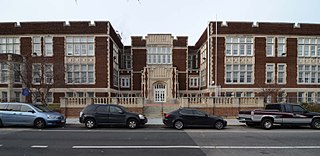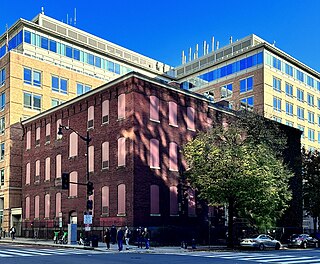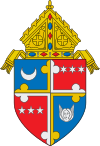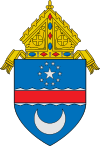
Columbia Heights is a neighborhood in Washington, D.C., located in Northwest D.C. It has diverse demographics, the DC USA shopping mall and many restaurants, BloomBars, Meridian Hill/Malcolm X Park, Howard University, Banneker Recreation Center, and All Souls Church.

Waddy Butler Wood was an American architect of the early 20th century and resident of Washington, D.C. Although Wood designed and remodeled numerous private residences, his reputation rested primarily on his larger commissions, such as banks, commercial offices, and government buildings. His most notable works include the Woodrow Wilson House and the Main Interior Building.

Normal School for Colored Girls established in Washington, D.C., in 1851 as an institution of learning and training for young African-American women, especially to train teachers.

The American Federation of Labor Building is a seven-story brick and limestone building located along Massachusetts Avenue in Washington, D.C. Completed in 1916, it served as the headquarters of the American Federation of Labor until 1955, when it merged with the Congress of Industrial Organizations to form the AFL–CIO. It remained a trade union headquarters until 2005, when it was sold to the developers of the Washington Marriott Marquis hotel. The building exterior, the only historical element remaining of the building, is now part of that structure. It was declared a National Historic Landmark in 1974. It housed the American Federation of Labor for 40 years.

The Embassy of Uzbekistan in Washington, D.C.,, is the diplomatic mission of the Republic of Uzbekistan to the United States. The current Ambassador of Uzbekistan to the United States is Furqat Sidikov. The embassy is located at 1746 Massachusetts Avenue NW on Embassy Row in Washington, D.C., between Scott Circle and Dupont Circle. Constructed in 1909, the Clarence Moore House is an example of Beaux Arts architecture in blond Roman brick with limestone dressings; it was used by the Canadian government until the 1980s. The house was listed on the National Register of Historic Places (NRHP) on April 3, 1973. The building is also designated a contributing property to the Massachusetts Avenue Historic District and Dupont Circle Historic District, which are both listed on the NRHP.

The Detroit–Columbia Central Office Building is a building located at 52 Selden Street in Midtown Detroit, Michigan. It is also known as the Michigan Bell Telephone Exchange. The building was listed on the National Register of Historic Places in 1997.

The Barnes and Thornburg Building is a high rise in Indianapolis, Indiana originally known as the Merchants National Bank Building. In 1905, the Merchants National Bank and Trust Company engaged the architectural firm of D. H. Burnham & Company of Chicago to design a new bank headquarters on the southeastern corner of the Washington and Meridian streets, the most important intersection in Indianapolis. Initial occupancy of the lower floors took place in 1908, while the upper floors were not completed until 1912.

The William J. Nealon Federal Building and United States Courthouse is a courthouse of the United States District Court for the Middle District of Pennsylvania, located in Scranton, Pennsylvania. It was completed in 1931, and was listed on the National Register of Historic Places in 2018.

The William O. Douglas Federal Building is a historic post office, courthouse, and federal office building located at Yakima in Yakima County, Washington. It is a courthouse for the United States District Court for the Eastern District of Washington. Renamed in 1978, it was previously known as U.S. Post Office and Courthouse, and is listed under that name in the National Register of Historic Places.

The Sulgrave Club is a private women's club located at 1801 Massachusetts Avenue NW on the east side of Dupont Circle in Washington, D.C. The clubhouse is the former Beaux-Arts mansion on Embassy Row built for Herbert and Martha Blow Wadsworth and designed by noted architect George Cary. During World War I the Wadsworth House was used as the local headquarters for the American Red Cross.
Bettendorf–Washington School, also known as the Bettendorf Park Board Fine Arts Annex, was a historic building located in Bettendorf, Iowa, United States. It was listed on the National Register of Historic Places in 1984.

The Reno School is a historic school building located at 4820 Howard Street NW, completed in 1903 to serve the needs of the Reno community in Washington, D.C. Like all public schools in the District at the time, it was segregated and served African American students in the area west of Rock Creek Park and north of Georgetown. The school was closed in 1950 after the Reno community was evicted to create Fort Reno Park and the adjacent Alice Deal Middle School.

Shaw Junior High School, now known as Asbury Dwellings, is a historic structure located in the Shaw neighborhood of Washington, D.C. It has been listed on the District of Columbia Inventory of Historic Sites and on the National Register of Historic Places since 2008.

John Mercer Langston School is a historic structure located in the Truxton Circle neighborhood in Washington, D.C. The two-story brick building was designed by Appleton P. Clark, Jr. The structure was completed in 1902. It was listed on the National Register of Historic Places in 2013.

Bruce-Monroe Elementary School at Park View is a bilingual elementary school in Washington, D.C. Named after Blanche Bruce and James Monroe, it has been located in the historic Park View School in the city's Park View neighborhood since 2008. It is part of the District of Columbia Public Schools.

Building 40, Army Medical School is a Georgian revival structure in the Walter Reed Army Medical Center complex in northern Washington, D.C., United States. It was built between 1922 and 1932 to house the Army Medical School, which became the Army Medical Center in 1923 when it — under the name “Medical Department Professional Service School” (MDPSS) — combined with the Walter Reed General Hospital. The MDPSS ultimately became the Walter Reed Army Institute of Research, which occupied Building 40 from 1953 to 1999. It comprises four wings, known as the Craig (1924), Sternberg and Vedder (1932), and Siler (1962) Pavilions and is situated at 14th and Dahlia Streets.

The Webster School, also called the Daniel Webster School, is a historic building located at 940 H Street NW in Washington, D.C. Built in 1882 as a segregated school for white children, it was among a large number of brick schools constructed in the city after the Civil War. These schools were located a couple of blocks from each other, allowing class sizes to be small. Most of the schools were two-story buildings, but some were larger and three stories. The Webster School was one of those larger schools.

Albert L. Harris was an American architect who worked primarily in Washington, D.C. He was born in Wales and emigrated to the United States as a young child. He worked for architectural firms in Chicago and Baltimore and then Washington, where he also obtained an architectural degree from George Washington University. He was a part-time professor there while also working for the US Navy and then the city of Washington where he served as the city's Municipal Architect from 1921 until his death in 1933. A number of his works are listed on the National Register of Historic Places (NRHP).

The Blanche K. Bruce School was an all-black school and community center during the Jim Crow era in the United States. In July 1898, the District of Columbia public school trustees ordered that a then new public school building on Marshall Street be named the Bruce School in his honor. The Bruce School building was designed by architect William M. Poindexter in Renaissance Revival style of red brick with stone and pressed metal trim, with two floors of four rooms each. In 1927, a Colonial Revival style eight-room annex was constructed, designed by architect Albert L. Harris.

The Freedman's Bank Building, previously known as the Treasury Annex, is a historic office building located on the corner of Madison Place and Pennsylvania Avenue NW in Washington, D.C. It sits on the east side of Lafayette Square, a public park on the north side of the White House, and across from the Treasury Building. The adjoining properties include the Howard T. Markey National Courts Building to the north and the former Riggs National Bank to the east.






















